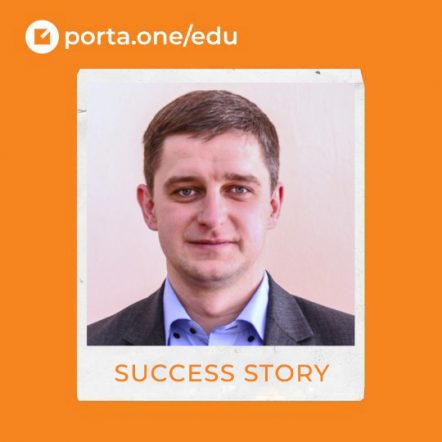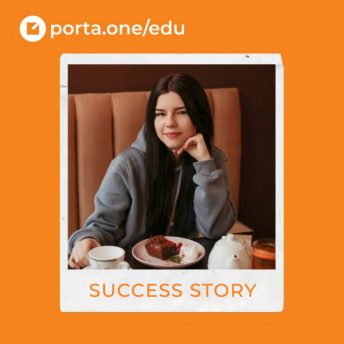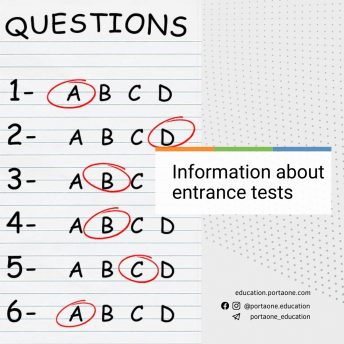In the 2019/2020 academic year he attended classes at the PortaOne Center on the par with his students combining his teaching, and successfully completed the program. Why did he need it and how did he benefit from it? Here’s our interview.
– In the spring of 2019, when you became a student at the PortaOne educational center, you were already working as the dean of department at Sumy University. Why did you come to study? What was your purpose?
I had been thinking for some years about the fact that our graduates didn’t meet 100% modern requirements of IT companies in the labor market. I was trying to figure out which subjects should be added to the curriculum to improve the situation. I analyzed the market of IT vacancies, which areas we did not cover with our current curriculum. And I found a gap, there’s a shortage of system administrators and devops engineers. So, we need to fill this gap as soon as possible. And that’s exactly what the PortaOne Training Center is doing. In my opinion, before you teach others, you should learn the ropes yourself first. That’s why I came to learn together with the students. Both Roman and the head of the education centre strongly supported me but with no special treatment. I attended all the classes, did all the tests on general basis.
– So, have you introduced new subjects to the curriculum?
So, from this academic term third year students can study the basics of Linux optionally. It’s two classes a week, theory and practice. 26 students opted for it. If it is in demand, we will expand the course on Linux by adding the basics of computer networks.
And by the way, not only the university improved its curriculum, but also did the Education Center .
– How so?
The point is that I have a Master’s in biomedical electronics. Attending the course I realized that I could be useful and offered to give a lecture on physics for IT specialists: why WiFi is harmful, what is worse – WiFi or micro oven, what WiFi, blue-tooth, micro oven, mobile phone have in common and what biological harm they can cause to tissues. As a result, my lecture lasted for an hour, and for two more hours the guys kept asking me questions. And we will definitely do it again!
– What was it like to study together with your students?
Before I joined the Center, I tried not to create any barriers between myself and the students. I have been teaching at the university since 2006, but I had graduated only two years before that. So, when I first entered the classroom and started teaching students, the age gap was minimal. Now, of course, it is getting bigger, but even today we are on the first-name term with some of my students.
Our university has its own business incubator, a small laboratory where students develop their own projects. We often do something together with students. They ask questions and we figure out what to do. So, I have experience in interacting with them on equal terms.
Anyway, I always say that students have at least one advantage over me. It’s their age. They are younger which means that they will definitely outperform us.
– Was there a lot of new material for you in the class? How did you build your learning process?
I already knew part of the program, some things were completely new (for example, everything about Linux). In general, I allocated the time the following way: 20% for the classroom , and 80% for self-study. I was very excited, I really enjoyed it. The time passed really quickly. Halfway through the course I was promoted to the position of the dean of the department. A lot of administrative tasks came up, and I didn’t have enough time for homework. That was difficult.
My recommendation: Do not expect the teacher to explain everything to you and just attending lectures is not enough . At least as much time (ideally two times as much) should be spent on self-study. The optimal ratio of work in class to self-study – 1:3, 1:2 is worse, 1:1 – absolutely not enough.
– What advice can you give to students?
Be patient and be enthusiastic. I would strongly recommend to spend as much time as possible on self-study
Communicate! Talk to your teacher. It feels nice when students ask questions. That means they are really into this! Roman, for example, never gives a direct answer. He is sort of preparing the students for this answer. So, they need to do the job to get to the bottom.
Also, it is very important to talk to other students in the group. For example, I often communicated with my classmates. In the evening we chatted on Twitter about the tasks.
Generally, it’s better to do the course with a friend or find a partner in the course. There are situations when it seems that you will never find a solution and you are about to quit . There should be someone to cheer you up.
“Sport fury” also helps and stimulates. You move forward against all odds. Because the friend has already solved the task, and if he could do it, I can do it too.
– What kind of mistakes would you like to avoid?
– I have a lot of experience as a teacher, so nothing comes to my mind. Well, yes, there were! I was very disappointed with the results of my first test. I was then convinced that only correct answers count like in our university tests. And it turned out that incorrect answers also affect the overall score, lowering it. So, if you hesitate, it is better to skip the question than to answer incorrectly. Roman explained it, but I, probably, ignored it. It serves me right.
– What was the brightest impression from the training process?
When Roman first brought the phone sets into the classroom, he introduced the interface and in 20 minutes we were able to make a few calls. And then Roma said: “And now imagine that you have ten thousand of these customers.” And we can understand the scale of it, the whole corporation behind all of this! I haven’t had such experience before, it was just a wow-effect.




